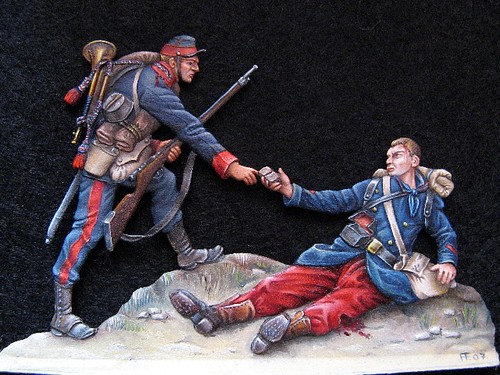When I bought the samples from Irregular Miniatures one of the heads I ordered was the 'EMH 4 1850's French/Italian/Austrian shako 50p'. I had thought (or hoped) that this was the same type of hat that my other French toy soldiers wear wearing (the short kepi), but it wasn't.
Instead I got a very tall shako - see left - which, I believe, is completely inappropriate for the French army of the period that I am interested in (1890-1910).

Well, I acquired Osprey's 'French Army 1870-71 Franco-Prussian War 1 - Imperial Troops' today and it seems that the French army began to replace this tall shako with the shorter kepi around 1868.
Left: French Grenadier, 1853.
From it's adoption the French kepi has evolved, from the early bec de canard (duck bill) - what we would recognise as the type worn by both sides in the American Civil War - to the pattern 1876 with a rounded visor, to the 1884 pattern which was the type used by French soldiers up to the First World War.
And so, in building a French regiment using Irregular Miniatures I have to decide whether to use their 'EMH 1 Kepi' (duck bill) or make my own heads with the later French kepi.
 |
| Wonderful vignette called 'Last Bullets' - This shows the early 'duck bill' kepi typical of the Franco-Prussian War (1870-71) |
I still have to research the various different models of kepi of the 1880-1914 period to understand the nuances in the differences, but unfortunately Irregular's 'duck bill' does not seem to suit this period (it's represents the type similar to that used during the Franco-Prussian War of 1870-71).
Right: Pattern 1876 kepi with rounded visor.
For my little French army I would favour versions of the kepi of the 1876 pattern and later 1884 pattern.
This all sounds a bit pernickety I know, and I don't count myself as being a 'button counter' when it comes to toy soldiers - but, the headgear is perhaps the most immediately identifiable item of dress that gives the toy soldier his unique identity so I would like to feel comfortable that I have that right at least.
Left: The 1884 pattern kepi with kepi covers. The covers are another thing that confuse the issue as they give the hat a slightly different look and shape!
The 1884 kepi remained with the French soldier right up and into the early years of the first world war. This is a good thing for me as it means I can use early WW1 French toy soldiers - like those made by Dorset Soldiers - knowing that the general French uniform changed little from that of the turn of the 19th century.
LOL - I am sure experts in French uniforms will find fault in my logic though!



No comments:
Post a Comment